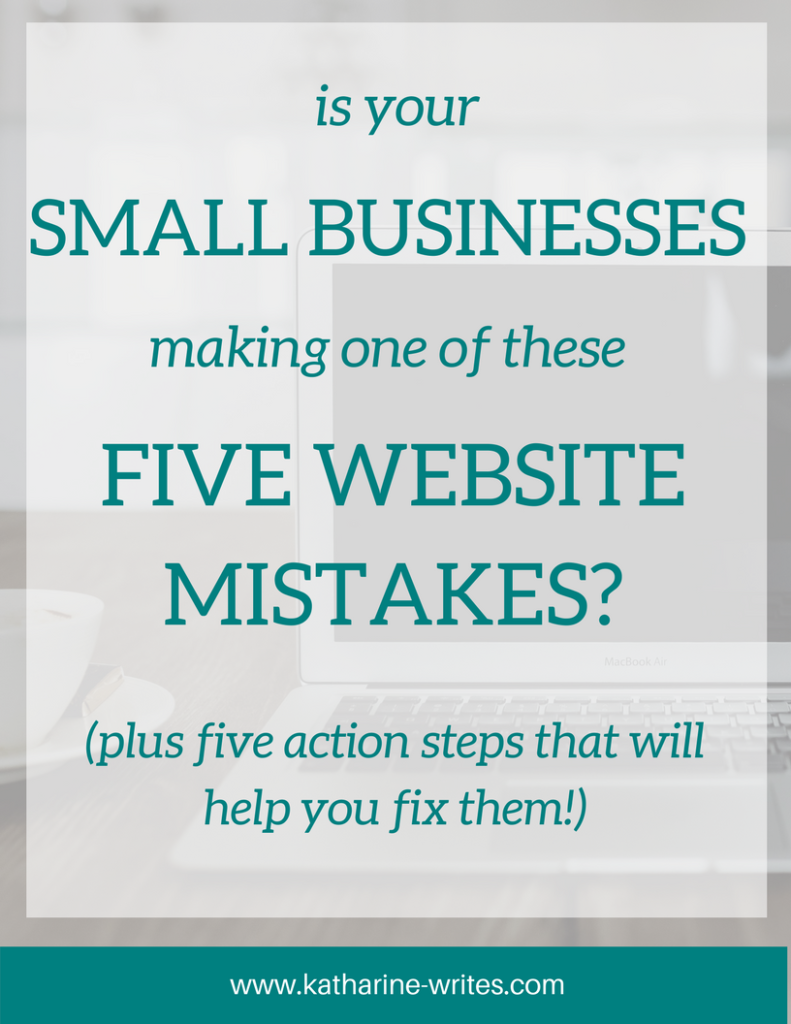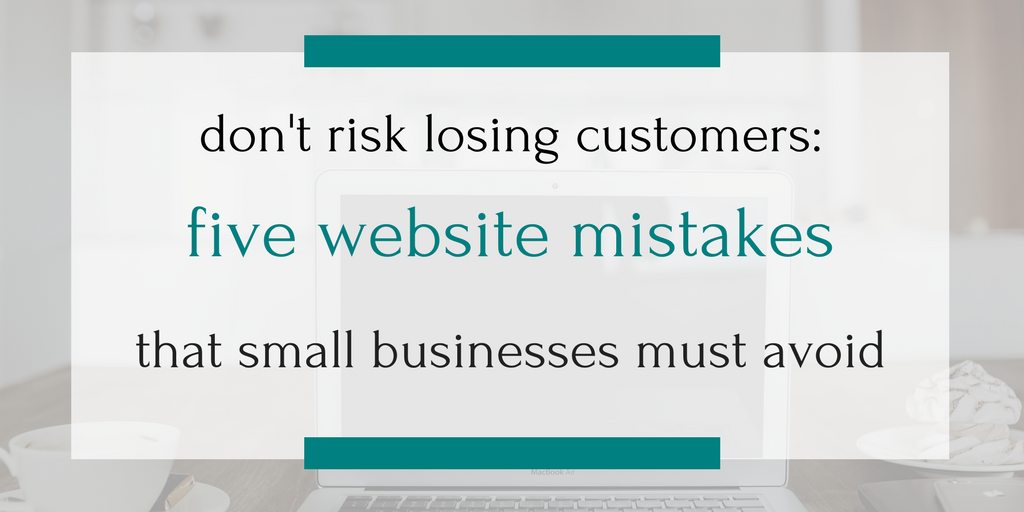
When it comes to creating a strong, successful website, there’s no magic formula.
There are hundreds of combinations of words, images, savvy marketing, interesting content, and the finding just the right audience that can work together to make a website that attracts the right people and lets your business shine.
But…
When it comes to getting things not quite right — or downright wrong — I see small businesses make a lot of the same mistakes.

To paraphrase Tolstoy, every successful website is unique, but all the dreadful ones are dreadful in the same ways. So let’s drive into those cringe-worthy errors to make sure you never have to worry about them chasing away your customers again.
5 Website Mistakes That Are Losing Customers for Your Small Business
1. Not thinking about visuals
Unsurprisingly, I place a huge value on the written content of a website. After all, that’s my line of business. Words are important! The right words make your business stand out like nothing else can.
But you know what can make your website stand out for the wrong reasons?
The wrong visual signals.
When a website sends the right visual signals, we almost don’t notice. The text, background, colors, layout, images, and overall design all play together so nicely and smoothly, looking just right for the industry and current internet aesthetic, that they’re basically invisible. You might think the website is nice, that it looks good. But your brain will rarely take the time to break down those visuals into individual elements and think, “What a nice white balance, and what appropriately chosen photography! This company is sending perfect visual signals.”
The visual elements of your website should be so professional looking, industry appropriate, and aesthetically pleasing that no one will notice them.
When you don’t think about your visuals, though, they stand out. Visitors will notice your oddly colored background, your out-of-date design, your blurry headshot, your font choice that is difficult to read. And they will notice each element individually, as well as taking in the overall, unfortunate whole.
This, I can guarantee you, will be bad for business. Because no one wants to spend time on a website that is unpleasant to look at.
Takeaway #1: Think about the visual elements of your website. Take time to make them look so good that no one notices they’re there.
2. Skipping critical information
A friend recently asked me to look at her website, which I was happy to do, of course. And there was a lot that was good there! Great visuals! Email capture! A well-written bio!
But then I looked for her contact page.
Spoiler: there wasn’t one.
No email address. No contact form. Not even links to social media. She was planning to use this website to make professional connections, but there was literally no way for anyone to connect with her.
Now, obviously, this is an extreme, and easily fixed, and somewhat silly example.
But there are many, many websites out there that are missing critical information.
There are store websites that list their location but not when they are open.
There are business that have a way for the press to send them inquiries but no way for customers to ask questions about products.
There are service pages that list services but don’t describe them.
Heck, I’ve even seen a consultant’s website that never once mentioned the industry he consulted for!
Of course, sometimes there are good reasons to leave information off. A lot of companies prefer customers contact them directly to find out prices, or don’t list employees’ emails, or avoid mentioning their street address because customers aren’t welcome to drop by. All that is totally reasonable.
But sometimes, whether through lack of proofreading or lack of thought about what your customers actually need, important information is just missing.
Takeaway #2: When planning each web page, list the 3 critical pieces of information visitors should be able to learn. Then make sure all three are there.
3. Non-intuitive navigation
Most websites have more than one section. The majority, but not all, of them have more than one page.
This means that visitors need to be able to find their way around, and they need to be able to do it easily.
If a certain page or piece of information isn’t easy to find, your customers aren’t going to spend hours trying to find it, especially if this is their first interaction with your company. Nope, they’re just going to go elsewhere and find a business whose website makes their lives easier, not harder.
And you’re going to lose their business.
Now, all that may seem fairly straightforward and easy to manage. But here’s where things get a little tricky:
Intuitive does not mean the same thing to everyone.
Take, for example, the time I was helping my mother plan out her new website. She’s a painter, and even though almost all her sales are in person, she needed a website where both former and potential buyers could learn more about her work.
While I was browsing designs with her, she pointed at one and said, “That part won’t work at all. I need one that says menu.”
The “part” she was referring to was the graphic of three little lines in the the top corner that meant “click here to see the menu.”
Now, those three little lines are a pretty common icon, especially on mobile sites. I knew what they meant. My mother knew what they meant. You probably would have known what they meant.
But many of the buyers who purchase my mother’s art are older and not particularly computer savvy. There was a good chance that many of them would not have known what that icon meant and would have ended up hunting around, trying to find a menu, before eventually giving up. My mother knew that, because she knew her audience.
Takeaway #3: Make sure your navigation is straightforward, not just to you, but to the audience that you are trying to attract.
4. Having dead pages
Imagine a customer scrolling through your website. They might be on your “About Us” page, learning more about your company’s history and mission. Imagine that they are your ideal customer, so what you they are reading it absolutely hitting the spot.
They’re thinking, “This company gets me.”
And then they get to the bottom of the page… and that’s it.
There’s nowhere for them to go. No link to your blog. No button to send them to your shop. No learn more option.
This is what we call a dead page: a page that just ends, with no internal navigation to take visitors to the next step.
You might think that, because they were interested ten seconds ago, they’ll scroll all the way back up to the top of the page and pick one of those options from your top navigation menu.
And you know, they might. There’s a chance that they have a plan in mind for what they want from your business, and that they’ll be willing to get there on their own.
But… they might not. A lot of customers, when confronted with a dead page, stop there.
Because most customers don’t actually know what they want next.
They don’t yet know enough about your company. They don’t know what services or products you have available. They don’t know what their options are… so how can they choose one?
They can’t. What they can do is leave the page.
And that’s what a lot of people will do.
But if you give them a next step — whether that’s signing up for your email list, visiting your shop, or seeing what packages you have to offer — they don’t have to choose. You’ve taken away their uncertainty. You’ve given them a path to follow.
If they follow it, they’ll stick around. And once someone sticks around, they’re much more likely to end up hooked.
Takeaway #4: Check every page. If any of them are dead, think about what you want visitors to do next and give them a clear path to make it happen.
5. Not picking an audience
I’ve written before about finding your target customer, and let’s be honest, I probably will again.
Because y’all, when it comes to website mistakes, not knowing who you are speaking to is the most damaging thing you can do to your business.
And yet, I see so many business, especially new ones, struggling with this. They are trying to appeal to everyone and anyone out there, to get someone or anyone to give them a chance.
I get it. Believe me. I too was once a new business. I too just wanted someone to hire me, and I was willing to bend over backwards and twist my business into knots trying to appeal to every possible customer out there.
But you know what?
When you try to have an audience of everyone, you actually just end up with an audience of no one.
Have you ever seen a clothing company try to sell “one size fits all” clothing? It wouldn’t work, because anyone who saw that piece of clothing advertised would just throw up their hands and yell, “But which size is it?!” And then they wouldn’t buy it, because clothing that’s designed to fit everyone probably fits no one.
That’s not to say that once you pick your target audience, you will never be able to sell your work to someone outside that audience. You almost certainly will!
But in order to create a compelling website, you need to speak to the people who need your business. They are the ones who are going to love you and love what you have to offer.
To create a strong, successful website, figure out who those people are. And then create a website that speaks directly to them.
Takeaway #5: Every page on your website should be written and designed specifically for the audience that you create in your target customer profile.
***
Creating a strong website is tough, y’all. But it is so essential to the success of your business. That’s why I want to hear from you!
What do you think are your website’s strengths? Where do you still struggle? What still confuses you about creating a website that attracts the right customers? Leave a comment below and let me know!
Thank you, this is very helpful.
So glad you found it helpful — if you have any questions I’d be happy to answer!